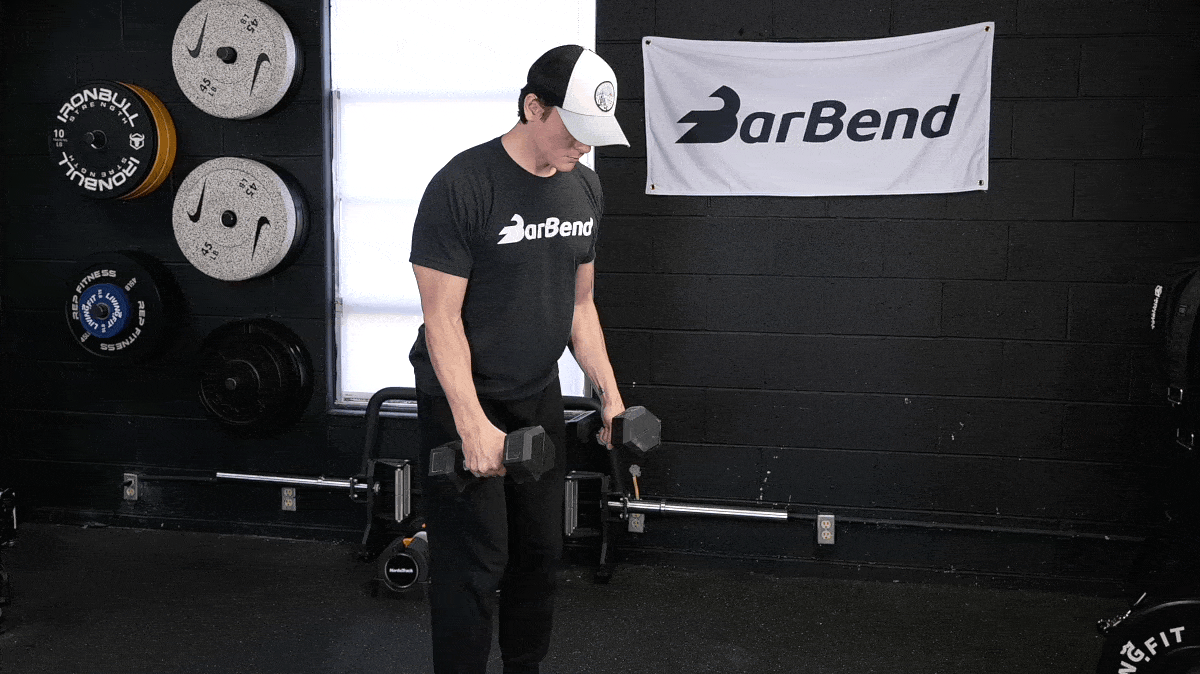In an earlier article, we discussed the upright row and its potential as a favorable training exercise for athletes seeking to increase movement-specific strength (such as in Olympic weightlifting), muscle hypertrophy (in the traps and deltoids), or improve performance in fitness WODs.
However, some athletes and coaches feel that this move provides greater risks to shoulder health than benefits.
In this article, we will discuss the potential drawbacks of performing upright rows, who is at risk, and some upright row alternatives to train around issues that may come up from upright rows.
Editor’s Note: The content on BarBend is intended to be informative in nature, but it is not a substitute for medical advice. If you’re experiencing pain in any movement, please consult the appropriate fitness and medical professionals.

Excessive Internal Rotation
Performing any type of movement with excessive loading and poor technique often spells disaster for joint and connective tissue health. In the upright row, this may be amplified due to the high amounts of internal rotation a lifter places their shoulder in when taking grip on the bar (especially the more narrow the grip is).
Often, if a lifter has pain in this internally rotated position (which, to be clear, is not an entirely bad position, since most Olympic weightlifters go into internal rotation without pain on a daily basis), it may be an indication of shoulder impingement syndrome (SIS). As a general rule of thumb, if you have pain in any joint via an exercise or movement, it is strongly advised not to continue to perform that movement. Then, be sure to get it checked out by a trained professional.
Some individuals will claim that upright rows are the devil, and other coaches and athletes will swear by them. The key point here is to understand that it does place the shoulder joint in internal rotation (which again, is not inherently bad).
If you have pain or are experiencing issues when performing upright rows, you may be having some impingement issues and/or are simply using too much weight with too little emphasis on proper technique. One test to determine if you have shoulder impingement issues is the Neer Test, which is shown below. It’s best done with the guidance of a trained professional.
High Amounts of Loading
This one is more user error-related, but nonetheless, a potential reason why upright rows may be the source of pain for some of you. When performing the upright row, we can actually “move” a large amount of weight relative to the strength of our posterior shoulder and deltoids (two main groups responsible for the movement). When lifters perform upright rows, issues often arise when heavy loads are moved via hip extension, shrugging, and heavy arm pulling (rather than a focused, smooth contraction from the shoulder muscles).
While this does not mean that the upright row is bad, it does suggest that lifters may have a problem with this lift, especially those who lack the ability to move freely in the shoulder joint and understand how to scale a muscle/movement.
Potential Shoulder Impingement Flare-Ups
As discussed above, the upright row may place some individuals at risk for shoulder impingement or even a shoulder injury syndrome (SIS). Due to the high amounts of internal rotation during the upright row (narrow grip), some lifters may find that their shoulder become inflamed and uncomfortable. If this is the case, it is best to have this checked out and stop performing upright rows until a professional addresses the situation.

Shoulders Hurt? Try These Upright Row Alternatives
If you find that traditional upright rows create pain in the shoulder, neck, or trap (other than some good old-fashioned muscle soreness), you need to first determine if you are, in fact, doing these movements correctly. Often, lifters will use excessive loads and let their shoulder joints crumble under excessive internal rotation.
If this is not the case, it may be that you need to try one of the upright row alternatives below and/or reduce the loads to focus on form.
Wide-Grip Upright Row/High Pull
While the normal upright row has a lifter taking a narrower grip, some people find that by simply increasing the grip width (such as in a snatch grip high pull), they can alleviate any pressure and pain in the shoulder. This wider grip will target more of the posterior shoulder, but it can be a good alternative for those who may have issues with a narrower grip.
Dumbbell Side/Lateral Raises
The upright row targets the upper traps and deltoids; however, it can be bothersome to some lifters. Simply swapping shoulder raises (which can be done at a variety of angles) can isolate the deltoids using lighter loads and allow for some manipulation on a case-by-case basis if a certain angle or grip is painful.

Cable Face Pulls
The cable face pull is extremely similar to the upright row; however, by changing the angle and grip attachment (rope instead of straight bar/dumbbell), you allow for some customization of grip and shoulder angles.
Additionally, by performing a more horizontal row (rather than a vertical row), you can take some pressure off the internal rotation and forward collapse of the shoulder and isolate the posterior shoulder (similar to that of a wider grip high pull).
Featured Image: PeopleImages.com – Yuri A